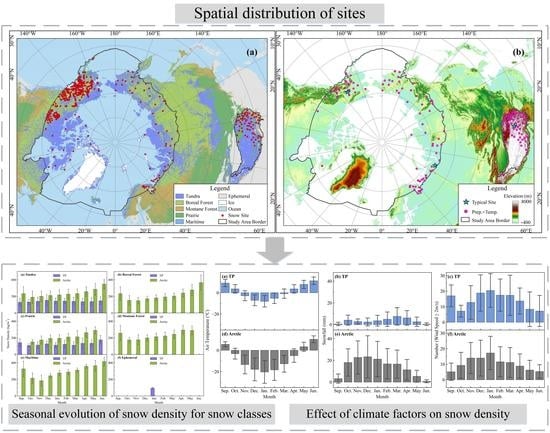Spatio-Temporal Characteristics and Differences in Snow Density between the Tibet Plateau and the Arctic
Abstract
1. Introduction
2. Materials and Methods
2.1. Data
2.1.1. Data Sources
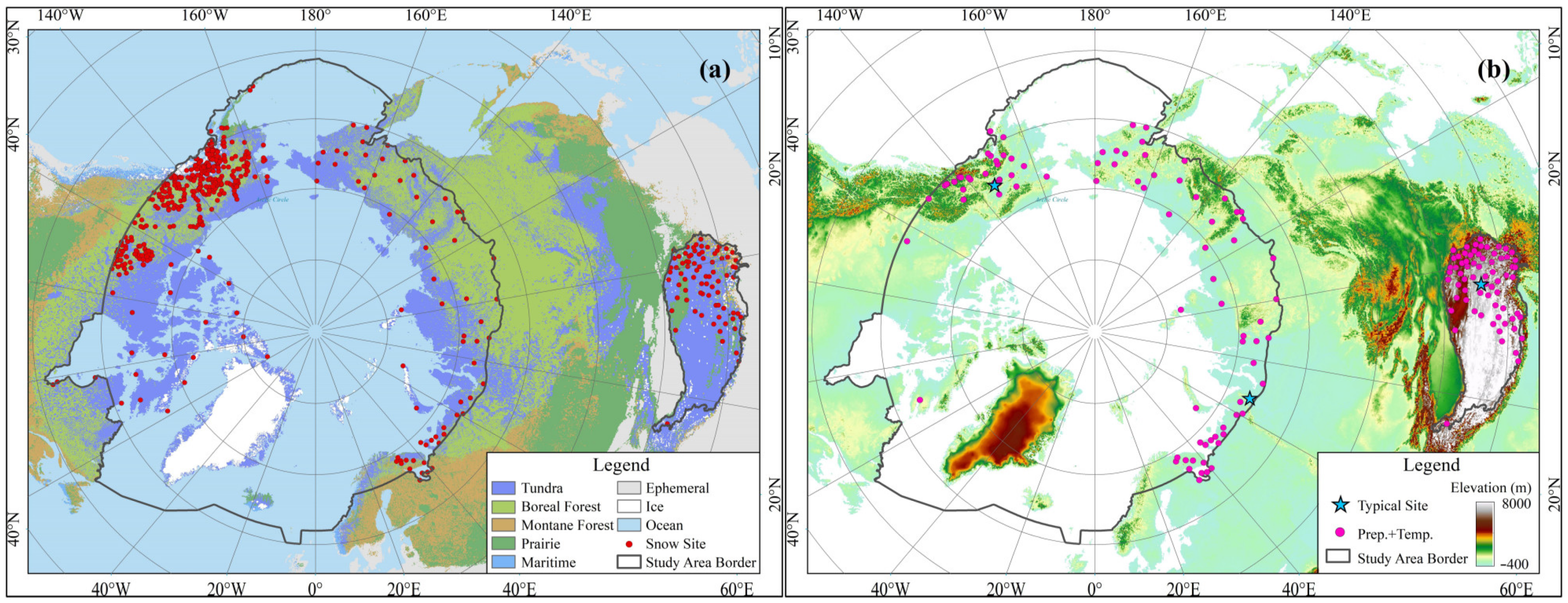
2.1.2. Data Quality Control
- In situ snow data
- b.
- Air temperature and precipitation data
2.1.3. Snow Classification
2.2. Method
2.2.1. Snow Density
2.2.2. Snowfall
3. Results
3.1. Spatial Heterogeneity of Snow Density
3.2. Seasonal Variation in Snow Density
3.3. Relationship between Snow Density and Environmental Factors
4. Discussion
4.1. Spatial and Temporal Patterns of Snow Density in the TP and the Arctic
4.2. Effect of Environmental Factors on Snow Density over Two Regions
5. Conclusions
Supplementary Materials
Author Contributions
Funding
Data Availability Statement
Acknowledgments
Conflicts of Interest
References
- Proksch, M.; Rutter, N.; Fierz, C.; Schneebeli, M. Intercomparison of snow density measurements: Bias, precision, and vertical resolution. Cryosphere 2016, 10, 371–384. [Google Scholar] [CrossRef]
- Zhang, T.; Osterkamp, T.; Stamnes, K. Influence of the Depth Hoar Layer of the Seasonal Snow Cover on the Ground Thermal Regime. Water Resour. Res. 1996, 32, 2075–2086. [Google Scholar] [CrossRef]
- Domine, F.; Picard, G.; Morin, S.; Barrere, M.; Madore, J.-B.; Langlois, A. Major Issues in Simulating Some Arctic Snowpack Properties Using Current Detailed Snow Physics Models: Consequences for the Thermal Regime and Water Budget of Permafrost. J. Adv. Model. Earth Syst. 2019, 11, 34–44. [Google Scholar] [CrossRef]
- Osokin, N.; Sosnovskiy, A.V.; Chernov, R.A. Effective thermal conductivity of snow and its variations. Earth’s Cryosphere 2017, 21, 60–68. [Google Scholar]
- Sugiyama, S.; Enomoto, H.; Fujita, S.; Fukui, K.; Nakazawa, F.; Holmlund, P.; Surdyk, S. Snow density along the route traversed by the Japanese-Swedish Antarctic Expedition 2007/08. J. Glaciol. 2012, 58, 529–539. [Google Scholar] [CrossRef]
- Mizukami, N.; Perica, S. Spatiotemporal Characteristics of Snowpack Density in the Mountainous Regions of the Western United States. J. Hydrometeorol. 2008, 9, 1416–1426. [Google Scholar] [CrossRef]
- Hannula, H.-R.; Lemmetyinen, J.; Kontu, A.; Derksen, C.; Pulliainen, J. Spatial and temporal variation of bulk snow properties in northern boreal and tundra environments based on extensive field measurements. Geosci. Instrum. Methods Data Syst. 2016, 5, 347–363. [Google Scholar] [CrossRef]
- Gergely, M.; Schneebeli, M.; Roth, K. First experiments to determine snow density from diffuse near-infrared transmittance. Cold Reg. Sci. Technol. 2010, 64, 81–86. [Google Scholar] [CrossRef]
- Zermatten, E.; Schneebeli, M.; Arakawa, H.; Steinfeld, A. Tomography-based determination of porosity, specific area and permeability of snow and comparison with measurements. Cold Reg. Sci. Technol. 2014, 97, 33–40. [Google Scholar] [CrossRef]
- Nayak, A.; Marks, D.; Chandler, D.; Seyfried, M. Long-Term Snow, Climate, and Streamflow Trends at the Reynolds Creek Experimental Watershed, Owyhee Mountains, Idaho, United States. Water Resour. Res. 2010, 46, W06519. [Google Scholar] [CrossRef]
- Venäläinen, P.; Luojus, K.; Lemmetyinen, J.; Pulliainen, J.; Moisander, M.; Takala, M. Impact of dynamic snow density on GlobSnow snow water equivalent retrieval accuracy. Cryosphere 2021, 15, 2969–2981. [Google Scholar] [CrossRef]
- Xiao, X.; Zhang, T.; Zhong, X.; Shao, W.; Li, X. Support vector regression snow-depth retrieval algorithm using passive microwave remote sensing data. Remote Sens. Environ. 2018, 210, 48–64. [Google Scholar] [CrossRef]
- Sturm, M.; Taras, B.; Liston, G.; Derksen, C.; Jonas, T.; Lea, J. Estimating Snow Water Equivalent Using Snow Depth Data and Climate Classes. J. Hydrometeorol. 2010, 11, 1380–1394. [Google Scholar] [CrossRef]
- Jörg-Hess, S.; Griessinger, N.; Zappa, M. Probabilistic Forecasts of Snow Water Equivalent and Runoff in Mountainous Areas. J. Hydrometeorol. 2015, 16, 2169–2186. [Google Scholar] [CrossRef]
- Fayad, A.; Gascoin, S.; Faour, G.; López-Moreno, J.; Drapeau, L.; Le Page, M.; Escadafal, R. Snow hydrology in Mediterranean mountain regions: A review. J. Hydrol. 2017, 551, 374–396. [Google Scholar] [CrossRef]
- Bormann, K.; Westra, S.; Evans, J.; McCabe, M. Spatial and temporal variability in seasonal snow density. J. Hydrol. 2013, 484, 63–73. [Google Scholar] [CrossRef]
- Judson, A.; Doesken, N. Density of Freshly Fallen Snow in the Central Rocky Mountains. Bull. Am. Meteorol. Soc. 2000, 81, 1577–1588. [Google Scholar] [CrossRef]
- Meløysund, V.; Leira, B.; Høiseth, K.; Lisø, K. Predicting snow density using meteorological data. Meteorol. Appl. 2007, 14, 413–423. [Google Scholar] [CrossRef]
- Arenson, L.; Colgan, W.; Marshall, H.P. Chapter 2-Physical, thermal, and mechanical properties of snow, ice, and permafrost. In Snow and Ice-Related Hazards, Risks, and Disasters, 2nd ed.; Haeberli, W., Whiteman, C., Eds.; Elsevier: Amsterdam, The Netherlands, 2021. [Google Scholar]
- Rasmus, S. Spatial and temporal variability of snow bulk density and seasonal snow densification behavior in Finland. Geophysica 2013, 49, 53–74. [Google Scholar]
- Colbeck, S.C. An overview of seasonal snow metamorphism. Rev. Geophys. 1982, 20, 45–46. [Google Scholar] [CrossRef]
- Seibert, J.; Jeníček, M.; Huss, M.; Ewen, T. Chapter 4—Snow and ice in the hydrosphere. In Snow and Ice-Related Hazards, Risks, and Disasters; Shroder, J.F., Haeberli, W., Whiteman, C., Eds.; Academic Press: Boston, MA, USA, 2015. [Google Scholar]
- Jepsen, S.; Molotch, N.; Williams, M.; Rittger, K.; Sickman, J. Interannual variability of snowmelt in the Sierra Nevada and Rocky Mountains, United States: Examples from two alpine watersheds. Water Resour. Res. 2012, 48, W02529. [Google Scholar] [CrossRef]
- Anderson, E.A. A Point Energy and Mass Balance Model of a Snow Cover; Technical Report; National Weather Service: Silver Spring, MD, USA, 1976.
- Derksen, C.; Lemmetyinen, J.; Toose, P.; Silis, A.; Pulliainen, J.; Sturm, M. Physical properties of Arctic versus subarctic snow: Implications for high latitude passive microwave snow water equivalent retrievals. J. Geophys. Res. Atmos. 2014, 119, 7254–7270. [Google Scholar] [CrossRef]
- Helfricht, K.; Hartl, L.; Koch, R.; Marty, C.; Olefs, M. Obtaining sub-daily new snow density from automated measurements in high mountain regions. Hydrol. Earth Syst. Sci. 2018, 22, 2655–2668. [Google Scholar] [CrossRef]
- Takala, M.; Luojus, K.; Pulliainen, J.; Derksen, C.; Lemmetyinen, J.; Kärnä, J.-P.; Koskinen, J.; Bojkov, B. Estimating Northern Hemisphere snow water equivalent for climate research through assimilation of space-borne radiometer data and ground-based measurements. Remote Sens. Environ. 2011, 115, 3517–3529. [Google Scholar] [CrossRef]
- Cao, B.; Gruber, S.; Zheng, D.; Li, X. The ERA5-Land soil temperature bias in permafrost regions. Cryosphere 2020, 14, 2581–2595. [Google Scholar] [CrossRef]
- Cao, B.; Arduini, G.; Zsoter, E. Brief communication: Improving ERA5-Land soil temperature in permafrost regions using an optimized multi-layer snow scheme. Cryosphere 2022, 16, 2701–2708. [Google Scholar] [CrossRef]
- Xue, Y.; Sun, S.; Kahan, D.; Jiao, Y. Impact of parameterizations in snow physics and interface processes on the simulation of snow cover and runoff at several cold region sites. J. Geophys. Res. 2003, 108, 8859. [Google Scholar] [CrossRef]
- Schwank, M.; Matzler, C.; Wiesmann, A.; Wegmuller, U.; Pulliainen, J.; Lemmetyinen, J.; Rautiainen, K.; Derksen, C.; Toose, P.; Drusch, M. Snow Density and Ground Permittivity Retrieved from L-Band Radiometry: A Synthetic Analysis. IEEE J. Sel. Top. Appl. Earth Obs. Remote Sens. 2015, 8, 3833–3845. [Google Scholar] [CrossRef]
- Conger, S.; McClung, D. Instruments and Methods Comparison of density cutters for snow profile observations. J. Glaciol. 2009, 55, 163–169. [Google Scholar] [CrossRef][Green Version]
- Matzl, M.; Schneebeli, M. Stereological measurement of the specific surface area of seasonal snow types: Comparison to other methods, and implications for mm-scale vertical profiling. Cold Reg. Sci. Technol. 2010, 64, 1–8. [Google Scholar] [CrossRef]
- Lundy, C.; Edens, M.; Brown, R. Measurement of snow density and microstructure using computed tomography. J. Glaciol. 2002, 48, 312–316. [Google Scholar] [CrossRef]
- Kaur, S.; Satyawali, P. Estimation of snow density from SnowMicroPen measurements. Cold Reg. Sci. Technol. 2016, 134, 1–10. [Google Scholar] [CrossRef]
- Sheng, J.; Mind’je, R.; Ting, F.; Li, L. Performance of snow density measurement systems in snow stratigraphies. Hydrol. Res. 2021, 52, 834–846. [Google Scholar]
- Valt, M.; Guyennon, N.; Salerno, F.; Petrangeli, A.B.; Salvatori, R.; Cianfarra, P.; Romano, E. Predicting new snow density in the Italian Alps: A variability analysis based on 10 years of measurements. Hydrol. Process. 2018, 32, 3174–3187. [Google Scholar] [CrossRef]
- Fassnacht, S.R.; Heun, C.; López-Moreno, J.I.; Latron, J. Variability of Snow Density Measurements in the Rio Esera Valley, Pyrenees Mountains, Spain. Cuad. Investig. Geogr. 2013, 36, 59–72. [Google Scholar] [CrossRef]
- You, Q.; Cai, Z.; Pepin, N.; Chen, D.; Ahrens, B.; Jiang, Z.; Wu, F.; Kang, S.; Zhang, R.; Wu, T.; et al. Warming amplification over the Arctic Pole and Third Pole: Trends, mechanisms and consequences. Earth-Sci. Rev. 2021, 217, 103625. [Google Scholar] [CrossRef]
- Cohen, J.; Screen, J.; Furtado, J.; Barlow, M.; Whittleston, D.; Coumou, D.; Francis, J.; Dethloff, K.; Entekhabi, D.; Overland, J.; et al. Recent Arctic amplification and extreme mid-latitude weather. Nat. Geosci. 2014, 7, 627–637. [Google Scholar] [CrossRef]
- Tang, Z.; Deng, G.; Hu, G.; Zhang, H.; Pan, H.; Sang, G. Satellite observed spatiotemporal variability of snow cover and snow phenology over high mountain Asia from 2002 to 2021. J. Hydrol. 2022, 613, 128438. [Google Scholar] [CrossRef]
- Tang, Z.; Wang, X.; Deng, G.; Wang, X.; Jiang, Z.; Sang, G. Spatiotemporal variation of snowline altitude at the end of melting season across High Mountain Asia, using MODIS snow cover product. Adv. Space Res. 2020, 66, 2629–2645. [Google Scholar] [CrossRef]
- Wang, J.; Tang, Z.; Deng, G.; Hu, G.; You, Y.; Zhao, Y. Landsat Satellites Observed Dynamics of Snowline Altitude at the End of the Melting Season, Himalayas, 1991–2022. Remote Sens. 2023, 15, 2534. [Google Scholar] [CrossRef]
- He, L.; Li, Z.-L.; Wang, X.; Xie, Y.; Ye, J.-S. Lagged precipitation effect on plant productivity is influenced collectively by climate and edaphic factors in drylands. Sci. Total Environ. 2021, 755, 142506. [Google Scholar] [CrossRef] [PubMed]
- He, L.; Xie, Y.; Wang, J.; Zhang, J.; Si, M.; Guo, Z.; Ma, C.; Bie, Q.; Li, Z.-L.; Ye, J.-S. Precipitation regimes primarily drive the carbon uptake in the Tibetan Plateau. Ecol. Indic. 2023, 154, 110694. [Google Scholar] [CrossRef]
- Tang, Z.; Wang, J.; Li, H.; Liang, J.; Li, C.; Wang, X. Extraction and assessment of snowline altitude over the Tibetan plateau using MODIS fractional snow cover data (2001 to 2013). J. Appl. Remote Sens. 2014, 8, 084689. [Google Scholar] [CrossRef]
- Kershaw, G.; McCulloch, J. Midwinter Snowpack Variation Across the Arctic Treeline, Churchill, Manitoba, Canada. Arct. Antarct. Alp. Res. 2007, 39, 9–15. [Google Scholar] [CrossRef]
- King, J.; Howell, S.; Brady, M.; Toose, P.; Derksen, C.; Haas, C.; Beckers, J. Local-scale variability of snow density on Arctic sea ice. Cryosphere 2020, 14, 4323–4339. [Google Scholar] [CrossRef]
- Ma, L.; Qin, D. Spatial-Temperal Characteristics of Observed Key Parameters for Snow Cover in China during 1957–2009. J. Glaciol. Geocryol. 2012, 34, 1–11. (In Chinese) [Google Scholar]
- Dai, L.; Che, T. The Spatio-Temperal Distribution of Snow Density and Its Influence Factors from 1999 to 2008 in China (in Chinese). J. Glaciol. Geocryol. 2010, 32, 861–866. [Google Scholar]
- Stuefer, S.L.; Kane, D.L.; Dean, K.M. Snow Water Equivalent Measurements in Remote Arctic Alaska Watersheds. Water Resour. Res. 2020, 56, e2019WR025621. [Google Scholar] [CrossRef]
- AMAP. Snow, Water, Ice and Permafrost in the Arctic (SWIPA) 2017; Arctic Monitoring and Assessment Programme (AMAP); AMAP: Oslo, Norway, 2017; pp. xiv + 269. [Google Scholar]
- Zhong, X.; Zhang, T.; Wang, K. Snow density climatology across the former USSR. Cryosphere 2014, 8, 785–799. [Google Scholar] [CrossRef]
- Liston, G.E.; Sturm, M. Global Seasonal-Snow Classification, Version 1; [Dataset]; National Snow and Ice Data Center: Boulder, CO, USA, 2021; Available online: https://nsidc.org/data/NSIDC-0768/versions/1 (accessed on 12 April 2022).
- Sturm, M.; Liston, G. Revisiting the Global Seasonal Snow Classification: An Updated Dataset for Earth System Applications. J. Hydrometeorol. 2021, 22, 2917–2938. [Google Scholar] [CrossRef]
- Muñoz Sabater, J. ERA5-Land Hourly Data from 1981 to Present; [Dataset]; Copernicus Climate Change Service (C3S) Climate Data Store (CDS): Reading, UK, 2019; Available online: https://cds.climate.copernicus.eu/cdsapp#!/dataset/reanalysis-era5-land?tab=form (accessed on 11 June 2022).
- Tolsdorf, T. Part622 National Engineering Handbook; United States Department of Agriculture, Natural Resources Conservation Service: Washington, DC, USA, 2010.
- Dawson, N.; Broxton, P.; Zeng, X.; Leuthold, M.; Barlage, M.; Holbrook, P. An Evaluation of Snow Initializations in NCEP Global and Regional Forecasting Models. J. Hydrometeorol. 2016, 17, 1885–1901. [Google Scholar] [CrossRef]
- Serreze, M.; Clark, M.; Armstrong, R.; McGinnis, D.; Pulwarty, R. Characteristics of the Western United States Snowpack from Snowpack Telemetry (SNOTEL) Data. Water Resour. Res. 1999, 35, 2145–2160. [Google Scholar] [CrossRef]
- Fassnacht, S.R.; López-Moreno, J.I. Patterns of trends in niveograph characteristics across the western United States from snow telemetry data. Front. Earth Sci. 2020, 14, 315–325. [Google Scholar] [CrossRef]
- Bulygina, O.; Groisman, P.; Razuvaev, V.; Korshunova, N. Changes in snow cover characteristics over Northern Eurasia since 1966. Environ. Res. Lett. 2011, 6, 045204. [Google Scholar] [CrossRef]
- Krenke, A. Former Soviet Union Hydrological Snow Surveys, 1966–1996; Version 1; NSIDC, National Snow and Ice Data Center: Boulder, CO, USA, 2002. [Google Scholar]
- NCDC. Documention for Data Set 3200 (DSI-3200); National Climatic Data Center: Asheville, NC, USA, 2006; p. 16.
- Doesken, N.J.; Judson, A. The Snow Booklet: A Guide to the Science, Climatology, and Measurement of Snow in the United States; Colorado Climate Center, Department of Atmospheric Science, Colorado State University: Fort Collins, CO, USA, 1997. [Google Scholar]
- Mote, T.; Grundstein, A.; Leathers, D.; Robinson, D. A comparison of modeled, remotely sensed, and measured snow water equivalent in the Northern Great Plains. Water Resour. Res. 2003, 39, 1209. [Google Scholar] [CrossRef]
- Dixon, D.; Boon, S. Comparison of the SnowHydro snow sampler with existing snow tube designs. Hydrol. Process. 2012, 26, 2555–2562. [Google Scholar] [CrossRef]
- Braaten, R. Canadian Snow Water Equivalent Database Main Documentation; Environment Canada, Climate Processes and Earth Observation Division: Dorval, QC, Canada, 1995; p. 25. [Google Scholar]
- Fang, B. Update of Canadian Historical Snow Survey Dataset; Environment and Climate Change Canada, Climate Research Division: Toronto, ON, Canada, 2017; p. 30.
- Brown, R.; Fang, B.; Mudryk, L. Update of Canadian Historical Snow Survey Data and Analysis of Snow Water Equivalent Trends, 1967–2016. Atmosphere-Ocean 2019, 57, 149–156. [Google Scholar] [CrossRef]
- CMA. Specifications for Surface Meteorological Observation-Snow Depth and Snow Pressure; China Meteorological Press: Beijing, China, 2017.
- Oyler, J.; Dobrowski, S.; Ballantyne, A.; Klene, A.; Running, S. Artificial Amplification of Warming Trends Across the Mountains of the Western United States. Geophys. Res. Lett. 2014, 42, 153–161. [Google Scholar] [CrossRef]
- Currier, W.; Thorson, T.; Lundquist, J. Independent Evaluation of Frozen Precipitation from WRF and PRISM in the Olympic Mountains, WA, USA. J. Hydrometeorol. 2017, 18, 2681–2703. [Google Scholar] [CrossRef]
- ECCC. Digital Archive of Canadian Climatological Data; Environment and Climate Change Canada: Montréal, QC, Canada, 2018.
- CMA. Standard Format of Documentation for Meteorological Dataset; China Meteorological Data Service Center: Beijing, China, 2012.
- Jennings, K.S.; Winchell, T.S.; Livneh, B.; Molotch, N.P. Spatial variation of the rain–snow temperature threshold across the Northern Hemisphere. Nat. Commun. 2018, 9, 1148. [Google Scholar] [CrossRef]
- Brown, R.D. Northern Hemisphere Snow Cover Variability and Change, 1915–1997. J. Clim. 2000, 13, 2339–2355. [Google Scholar] [CrossRef]
- Derksen, C.; Sturm, M.; Liston, G.; Holmgren, J.; Huntington, H.; Silis, A.; Solie, D. Northwest Territories and Nunavut Snow Characteristics from a Subarctic Traverse: Implications for Passive Microwave Remote Sensing. J. Hydrometeorol. 2009, 10, 448–463. [Google Scholar] [CrossRef]
- Wang, H.; Zhang, X.; Xiao, P.; Che, T.; Zheng, Z.; Dai, L.; Luan, W. Towards Large-Scale Daily Snow Density Mapping with Spatiotemporally Aware Model and Multi-Source Data. Cryosphere Discuss. 2022, 17, 33–50. [Google Scholar] [CrossRef]
- Guyennon, N.; Valt, M.; Salerno, F.; Petrangeli, A.B.; Romano, E. Estimating the snow water equivalent from snow depth measurements in the Italian Alps. Cold Reg. Sci. Technol. 2019, 167, 102859. [Google Scholar] [CrossRef]
- Pulliainen, J.; Hallikainen, M. Retrieval of Regional Snow Water Equivalent from Space-Borne Passive Microwave Observations. Remote Sens. Environ. 2001, 75, 76–85. [Google Scholar] [CrossRef]
- Dutra, E.; Balsamo, G.; Viterbo, P.; Miranda, P.M.A.; Beljaars, A.; Schär, C.; Elder, K. An Improved Snow Scheme for the ECMWF Land Surface Model: Description and Offline Validation. J. Hydrometeorol. 2010, 11, 899–916. [Google Scholar] [CrossRef]
- RIHMI-WDC: Russian Research Institute for Hydro-Meteorological Information-World Data Center. [Dataset]. Available online: http://meteo.ru/data (accessed on 21 July 2020).
- NCAR: National Center for Atmospheric Research. [Dataset]. Available online: https://rda.ucar.edu/datasets/ds510.0/ (accessed on 1 September 2020).
- NWCC: National Water and Climate Center. [Dataset]. Available online: https://www.nrcs.usda.gov/wps/portal/wcc/home/snowClimateMonitoring/snowpack (accessed on 11 October 2020).
- MSC: Meteorological Service of Canada. [Dataset]. Available online: https://dd.weather.gc.ca/climate/observations/daily/csv/ (accessed on 9 July 2020).
- CMA: China Meteorological Administration. [Dataset]. Available online: http://data.cma.cn/en/ (accessed on 28 July 2020).


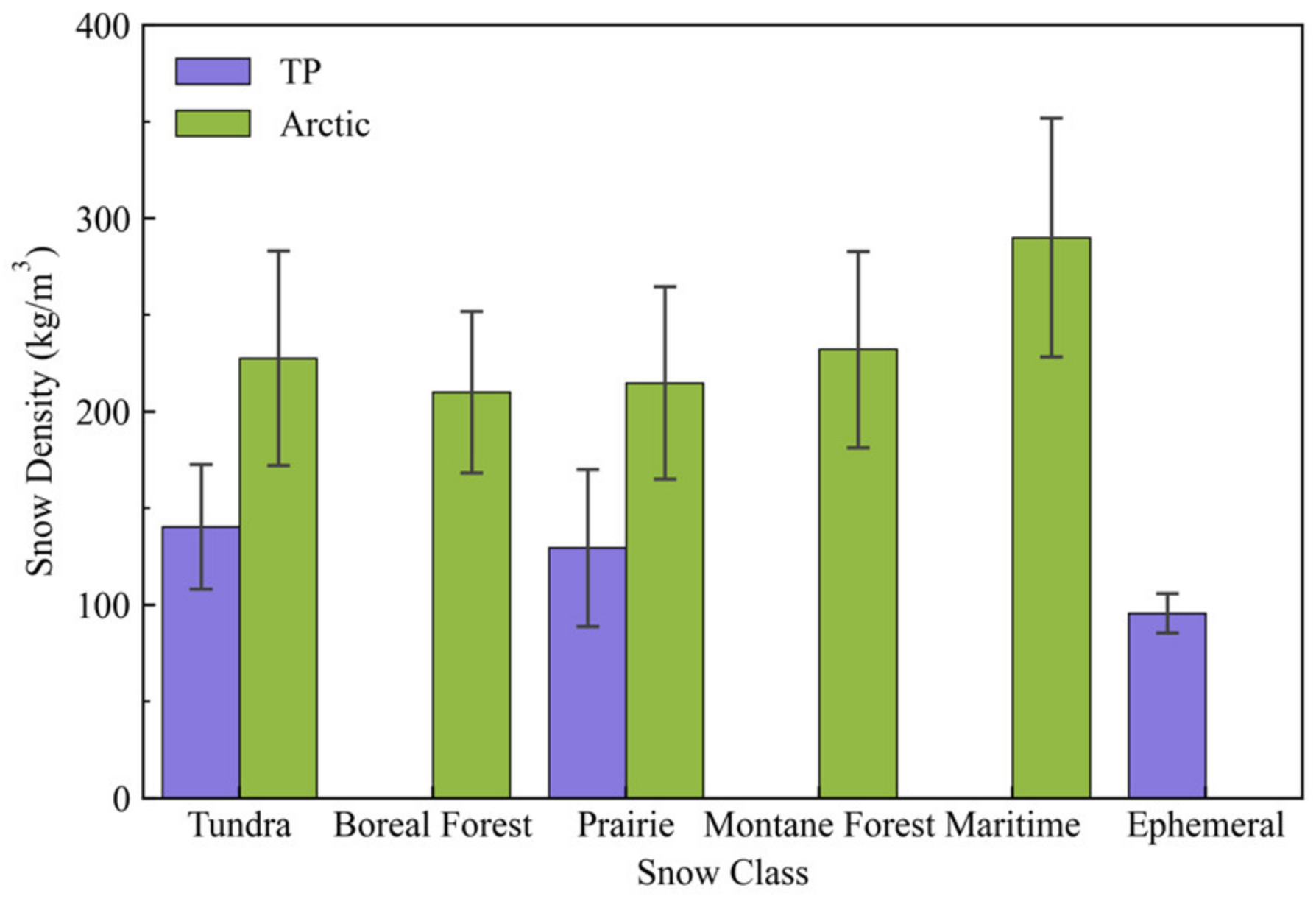
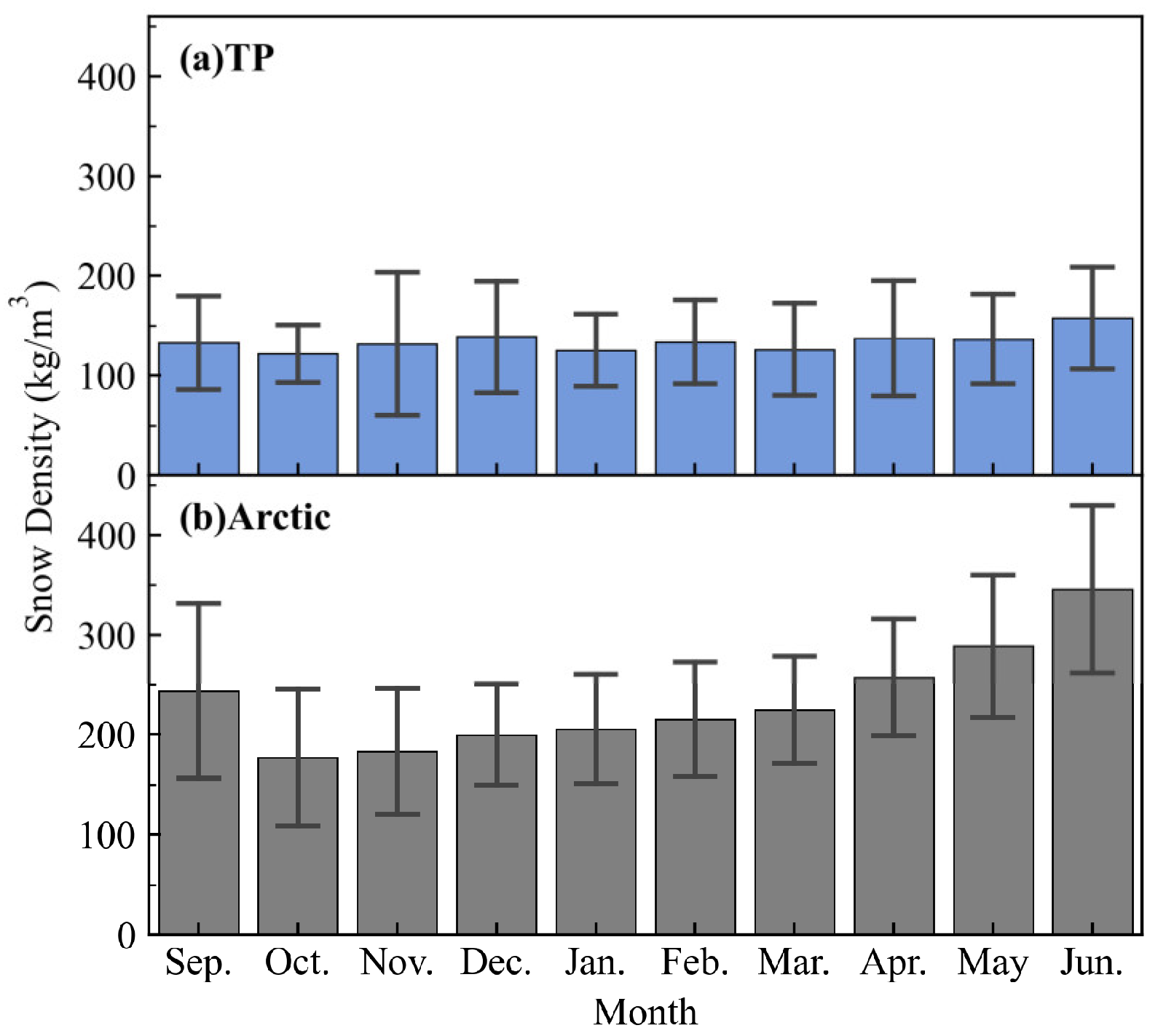
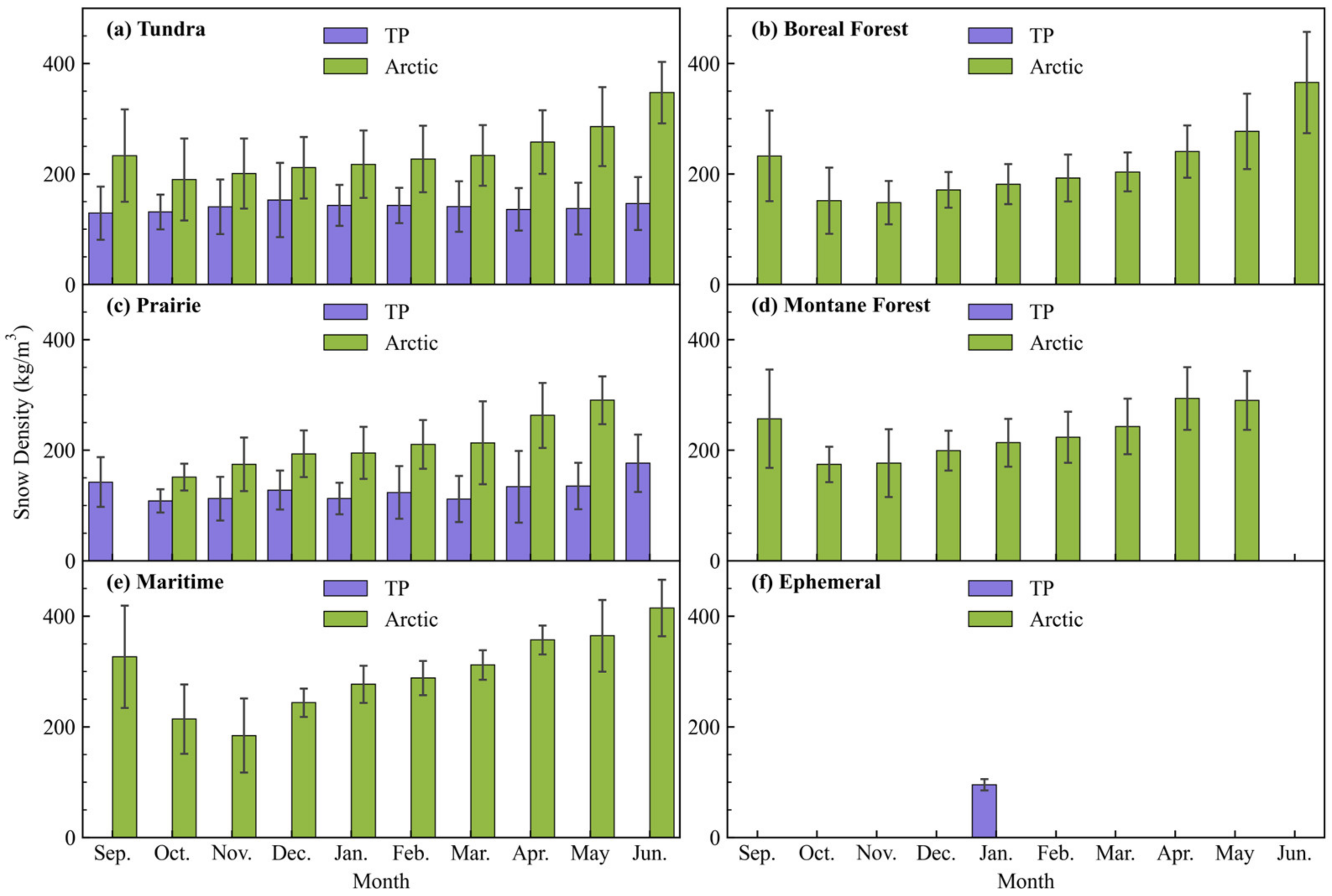



Disclaimer/Publisher’s Note: The statements, opinions and data contained in all publications are solely those of the individual author(s) and contributor(s) and not of MDPI and/or the editor(s). MDPI and/or the editor(s) disclaim responsibility for any injury to people or property resulting from any ideas, methods, instructions or products referred to in the content. |
© 2023 by the authors. Licensee MDPI, Basel, Switzerland. This article is an open access article distributed under the terms and conditions of the Creative Commons Attribution (CC BY) license (https://creativecommons.org/licenses/by/4.0/).
Share and Cite
Zhao, W.; Mu, C.; Wu, X.; Zhong, X.; Peng, X.; Liu, Y.; Sun, Y.; Liang, B.; Zhang, T. Spatio-Temporal Characteristics and Differences in Snow Density between the Tibet Plateau and the Arctic. Remote Sens. 2023, 15, 3976. https://doi.org/10.3390/rs15163976
Zhao W, Mu C, Wu X, Zhong X, Peng X, Liu Y, Sun Y, Liang B, Zhang T. Spatio-Temporal Characteristics and Differences in Snow Density between the Tibet Plateau and the Arctic. Remote Sensing. 2023; 15(16):3976. https://doi.org/10.3390/rs15163976
Chicago/Turabian StyleZhao, Wenyu, Cuicui Mu, Xiaodong Wu, Xinyue Zhong, Xiaoqing Peng, Yijing Liu, Yanhua Sun, Benben Liang, and Tingjun Zhang. 2023. "Spatio-Temporal Characteristics and Differences in Snow Density between the Tibet Plateau and the Arctic" Remote Sensing 15, no. 16: 3976. https://doi.org/10.3390/rs15163976
APA StyleZhao, W., Mu, C., Wu, X., Zhong, X., Peng, X., Liu, Y., Sun, Y., Liang, B., & Zhang, T. (2023). Spatio-Temporal Characteristics and Differences in Snow Density between the Tibet Plateau and the Arctic. Remote Sensing, 15(16), 3976. https://doi.org/10.3390/rs15163976





